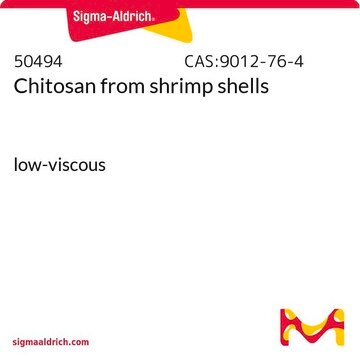This product is not considered a low molecular weight option. The material is a fairly crude, practical grade. Historical data indicates an estimated molecular weight range of 190 - 375 kDa.
Wichtige Dokumente
C3646
Chitosan
from shrimp shells, ≥75% (deacetylated)
Synonym(e):
Deacetyliertes Chitin, Poly(D-glucosamin)
About This Item
Empfohlene Produkte
Biologische Quelle
shrimp shells
Qualitätsniveau
Assay
≥75% (deacetylated)
Form
powder or flakes
Farbe
white to beige
mp (Schmelzpunkt)
102.5 °C ((216.5 °F ))
Löslichkeit
acetic acid: water: 10 mg/mL, slightly hazy to hazy (with extensive sonication)
H2O: insoluble
organic solvents: insoluble
Schüttdichte
0.15‑0.3 g/cm3
Lagertemp.
room temp
SMILES String
N([C@H]1[C@@H](O[C@@H]([C@H]([C@@H]1O)O[C@@H]4O[C@@H]([C@H]([C@@H]([C@H]4N)O)O[C@@H]5O[C@@H]([C@H]([C@@H]([C@H]5N)O)O[C@@H]6O[C@@H]([C@H]([C@@H]([C@H]6N)O)O[C@@H]7O[C@@H]([C@H]([C@@H]([C@H]7N)O)O[C@@H]8O[C@@H]([C@H]([C@@H]([C@H]8N)O)O[C@@H]9O[C@@H]([C@H](
InChI
1S/C56H103N9O39/c1-87-56(86)65-28-38(84)46(19(10-74)96-55(28)104-45-18(9-73)95-49(27(64)37(45)83)97-39-12(3-67)88-47(85)20(57)31(39)77)103-54-26(63)36(82)44(17(8-72)94-54)102-53-25(62)35(81)43(16(7-71)93-53)101-52-24(61)34(80)42(15(6-70)92-52)100-51-23(60)33(79)41(14(5-69)91-51)99-50-22(59)32(78)40(13(4-68)90-50)98-48-21(58)30(76)29(75)11(2-66)89-48/h11-55,66-85H,2-10,57-64H2,1H3,(H,65,86)/t11-,12-,13-,14-,15-,16-,17-,18-,19-,20-,21-,22-,23-,24-,25-,26-,27-,28-,29-,30-,31-,32-,33-,34-,35-,36-,37-,38-,39-,40-,41-,42-,43-,44-,45-,46-,47-,48+,49+,50+,51+,52+,53+,54+,55+/m1/s1
InChIKey
FLASNYPZGWUPSU-SICDJOISSA-N
Suchen Sie nach ähnlichen Produkten? Aufrufen Leitfaden zum Produktvergleich
Anwendung
Leistungsmerkmale und Vorteile
Qualität
Angaben zur Herstellung
Hinweis zur Analyse
Sonstige Hinweise
Lagerklassenschlüssel
11 - Combustible Solids
WGK
nwg
Flammpunkt (°F)
Not applicable
Flammpunkt (°C)
Not applicable
Persönliche Schutzausrüstung
Eyeshields, Gloves, type N95 (US)
Hier finden Sie alle aktuellen Versionen:
Analysenzertifikate (COA)
Die passende Version wird nicht angezeigt?
Wenn Sie eine bestimmte Version benötigen, können Sie anhand der Lot- oder Chargennummer nach einem spezifischen Zertifikat suchen.
Besitzen Sie dieses Produkt bereits?
In der Dokumentenbibliothek finden Sie die Dokumentation zu den Produkten, die Sie kürzlich erworben haben.
Artikel
Carcinogenic compounds in elastomers: 1,3-butadiene and isoprene used in elastomer manufacturing, classified as carcinogenic by IARC.
-
C3646 chitosan is lower molecular weight? What is the molecular weight range?
1 Antwort-
Hilfreich?
-
-
How can I determine the shelf life / expiration / retest date of this product?
1 Antwort-
If this product has an expiration or retest date, it will be shown on the Certificate of Analysis (COA, CofA). If there is no retest or expiration date listed on the product's COA, we do not have suitable stability data to determine a shelf life. For these products, the only date on the COA will be the release date; a retest, expiration, or use-by-date will not be displayed.
For all products, we recommend handling per defined conditions as printed in our product literature and website product descriptions. We recommend that products should be routinely inspected by customers to ensure they perform as expected.
For products without retest or expiration dates, our standard warranty of 1 year from the date of shipment is applicable.
For more information, please refer to the Product Dating Information document: https://www.sigmaaldrich.com/deepweb/assets/sigmaaldrich/marketing/global/documents/449/386/product-dating-information-mk.pdfHilfreich?
-
-
How is shipping temperature determined? And how is it related to the product storage temperature?
1 Antwort-
Products may be shipped at a different temperature than the recommended long-term storage temperature. If the product quality is sensitive to short-term exposure to conditions other than the recommended long-term storage, it will be shipped on wet or dry-ice. If the product quality is NOT affected by short-term exposure to conditions other than the recommended long-term storage, it will be shipped at ambient temperature. As shipping routes are configured for minimum transit times, shipping at ambient temperature helps control shipping costs for our customers. For more information, please refer to the Storage and Transport Conditions document: https://www.sigmaaldrich.com/deepweb/assets/sigmaaldrich/marketing/global/documents/316/622/storage-transport-conditions-mk.pdf
Hilfreich?
-
-
What is the Department of Transportation shipping information for this product?
1 Antwort-
Transportation information can be found in Section 14 of the product's (M)SDS.To access the shipping information for this material, use the link on the product detail page for the product.
Hilfreich?
-
-
What is the molecular weight of Product C3646, Chitosan from shrimp shells?
1 Antwort-
Sigma-Aldrich has not determined an average molecular weight or a molecular weight range for this product.
Hilfreich?
-
-
Is Product C3646, Chitosan from shrimp shells, USP grade?
1 Antwort-
No, this product is not considered USP grade.
Hilfreich?
-
-
What is the pKa of Product C3646, Chitosan from shrimp shells?
1 Antwort-
The amino group in chitosan has a pKa value of ~6.5.
Hilfreich?
-
Aktive Filter
Unser Team von Wissenschaftlern verfügt über Erfahrung in allen Forschungsbereichen einschließlich Life Science, Materialwissenschaften, chemischer Synthese, Chromatographie, Analytik und vielen mehr..
Setzen Sie sich mit dem technischen Dienst in Verbindung.




